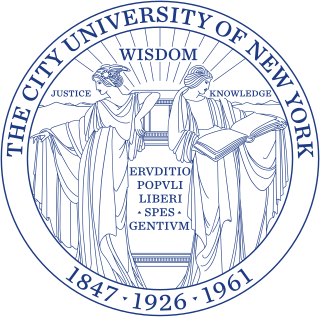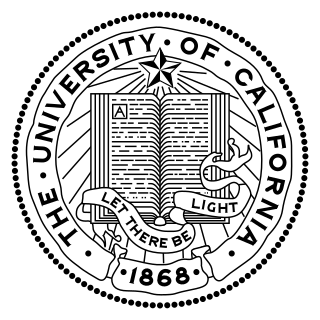
The City University of New York is the public university system of New York City. It is the largest urban university system in the United States, comprising 25 campuses: eleven senior colleges, seven community colleges, and seven professional institutions. In 1960, John R. Everett became the first chancellor of the Municipal College System of New York City, later known as the City University of New York (CUNY). CUNY, established by New York state legislation in 1961 and signed into law by Governor Nelson Rockefeller, was an amalgamation of existing institutions and a new graduate school.

The University of California (UC) is a public land-grant research university system in the U.S. state of California. Headquartered in Oakland, the system is composed of its ten campuses at Berkeley, Davis, Irvine, Los Angeles, Merced, Riverside, San Diego, San Francisco, Santa Barbara, and Santa Cruz, along with numerous research centers and academic centers abroad. The system is the state's land-grant university.

The California State University is a public university system in California, and the largest public university system in the United States. It consists of 23 campuses and seven off-campus centers, which together enroll 457,992 students and employ 56,256 faculty and staff members. In California, it is one of the three public higher education systems, along with the University of California and the California Community Colleges systems. The CSU system is officially incorporated as The Trustees of the California State University, and is headquartered in Long Beach, California.

The State University of New York is a system of public colleges and universities in the State of New York. It is one of the largest comprehensive systems of universities, colleges, and community colleges in the United States. Led by chancellor John B. King, the SUNY system has 91,182 employees, including 32,496 faculty members, and some 7,660 degree and certificate programs overall and a $13.37 billion budget. Its flagship universities are SUNY Stony Brook on Long Island in southeastern New York and SUNY Buffalo in the west. Its research university centers also include SUNY Binghamton and SUNY Albany.

A flagship is a vessel used by the commanding officer of a group of naval ships, characteristically a flag officer entitled by custom to fly a distinguishing flag. Used more loosely, it is the lead ship in a fleet of vessels, typically the first, largest, fastest, most heavily armed, or best known.

The State University of New York at Binghamton is a public research university with campuses in Binghamton, Vestal, and Johnson City, New York. It is one of the four university centers in the State University of New York (SUNY) system. As of Spring 2022, 18,148 undergraduate and graduate students attended the university.

The University of Houston is a public research university in Houston, Texas. It was established in 1927 as Houston Junior College, a coeducational institution and one of multiple junior colleges formed in the first decades of the 20th century. In 1934, HJC was restructured as a four-year degree-granting institution and renamed as the University of Houston. In 1977, it became the founding member of the University of Houston System. Today, Houston is the fourth-largest university in Texas, awarding 11,156 degrees in 2023. As of 2024, it has a worldwide alumni base of 331,672.
In the United States, a statutory college or contract college is a higher education college or school that is a component of an independent, private university that has been designated by the state legislature to receive significant, ongoing public funding from that respective state. The statutory college is operated by the university with state funding used to serve specific educational needs of the state.
Education in Kansas is governed at the primary and secondary school level by the Kansas State Board of Education. The state's public colleges and universities are supervised by the Kansas Board of Regents.
A chancellor is a leader of a college or university, usually either the executive or ceremonial head of the university or of a university campus within a university system.
In the United States, a board often governs institutions of higher education, including private universities, state universities, and community colleges. In each US state, such boards may govern either the state university system, individual colleges and universities, or both. In general, they operate as a board of directors, and they vary by formal name, size, powers, and membership. In some states, members are appointed by the governor.
For over 60 years, the Council for International Exchange of Scholars (CIES) has helped administer the Fulbright Scholar Program, the U.S. government's flagship academic exchange effort, on behalf of the United States Department of State, Bureau of Educational and Cultural Affairs. Founded in 1947, CIES is a private organization with a staff of around 60 people supplemented by 300 voluntary peer reviewers, primarily academics. CIES is a division of the Institute of International Education (IIE).
A university system is a set of multiple affiliated universities and colleges that are usually geographically distributed. Typically, all member universities in a university system share a common component among all of their various names. Usually, all member universities of a university system are governed by a system-wide governing body, such as a board of trustees or a board of regents. In the United States, many states have one or two state university systems under which many of their publicly funded universities are aligned, both in name and in governance. Additionally, for-profit universities, such as DeVry University, often have multiple campuses which share the same name; these may be, but are not always, described as a university system.
This article is intended to give an overview of the education in Houston.

Texas has over 1,000 public school districts—all but one of the school districts in Texas are independent, separate from any form of municipal or county government. School districts may cross city and county boundaries. Independent school districts have the power to tax their residents and to assert eminent domain over privately owned property. The Texas Education Agency (TEA) oversees these districts, providing supplemental funding, but its jurisdiction is limited mostly to intervening in poorly performing districts.
In the U.S. state of New York, public education is overseen by the University of the State of New York (USNY), its policy-setting Board of Regents, and its administrative arm, the New York State Education Department; this includes all public primary, middle-level, and secondary education in the state. The New York City Department of Education, which manages the public school system in New York City, is the largest school district in the United States, with more students than the combined population of eight U.S. states. Over 1 million students are taught in more than 1,200 separate public and private schools throughout the state.

Student governments in the United States exist in both secondary and higher education. At the collegiate level, the most common name is Student Government, according to the American Student Government Association's database of all student governments throughout the United States. The next most common name is the student government association. Other names are student senate, associated students, or less commonly students' union. There was one instance of a government of the student body, at Iowa State University. At Yale University, the undergraduate student government is known as the Yale College Council. High school student governments usually are known as Student Council.
The Association of Public and Land-grant Universities (APLU) is a research, policy, and advocacy organization of public research universities, land-grant institutions, state university systems, and higher education organizations. It has member campuses in all of the United States as well as the District of Columbia, four U.S. territories, Canada, and Mexico.










